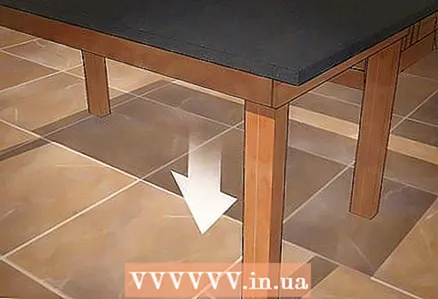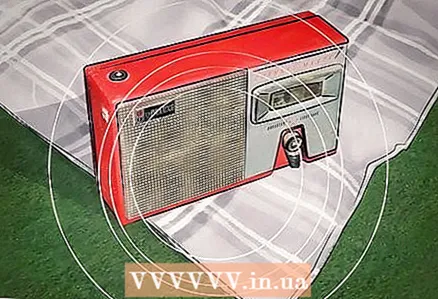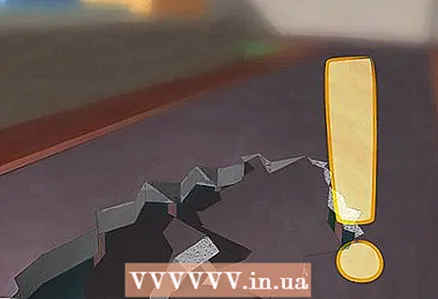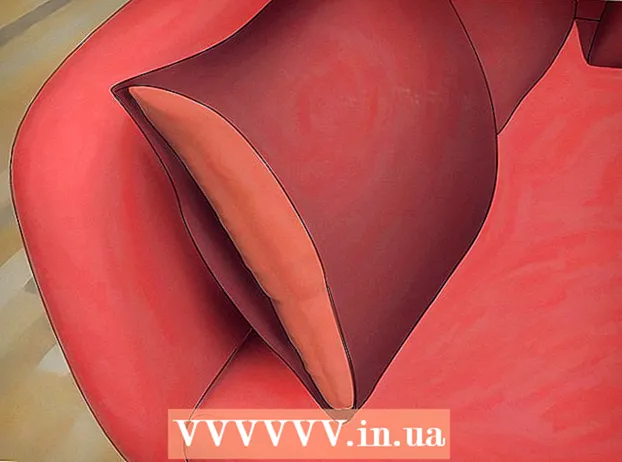Author:
Eric Farmer
Date Of Creation:
4 March 2021
Update Date:
27 June 2024

Content
- Steps
- Part 1 of 3: How to protect yourself indoors during an earthquake
- Part 2 of 3: How to behave after an earthquake
- Part 3 of 3: How to Prepare for an Earthquake
- Tips
Do you know what to do if you find yourself indoors during an earthquake? Many modern buildings are designed to withstand moderate earthquakes and provide the relative safety of the occupants. However, we must not forget about the danger posed by falling things, broken glass and the like.
Steps
Part 1 of 3: How to protect yourself indoors during an earthquake
 1 Stay inside. At the onset of an earthquake, it may be tempting to run outside. After all, nothing will fall on you there. But the point is, you hardly have time to get out before everything starts to fall, so it is better to find a safe place in the room than trying to leave the building.
1 Stay inside. At the onset of an earthquake, it may be tempting to run outside. After all, nothing will fall on you there. But the point is, you hardly have time to get out before everything starts to fall, so it is better to find a safe place in the room than trying to leave the building.  2 Turn off the stove and take other safety precautions before doing so. Before hiding, quickly turn off the stove. If you have candles burning, they also need to be extinguished.
2 Turn off the stove and take other safety precautions before doing so. Before hiding, quickly turn off the stove. If you have candles burning, they also need to be extinguished. - It is important to take precautions before the earthquake intensifies.
 3 Get down to the floor. The floor is the safest place in a room during an earthquake. However, you don't need to lie flat on the floor; instead, get on all fours.
3 Get down to the floor. The floor is the safest place in a room during an earthquake. However, you don't need to lie flat on the floor; instead, get on all fours. - This position is optimal for two reasons. First, you can move if necessary. Secondly, this way you will at least slightly protect yourself from falling objects.
 4 Find a safe place. The best place during an earthquake is under a table. A table, whether dining or writing, will protect you from falling objects.
4 Find a safe place. The best place during an earthquake is under a table. A table, whether dining or writing, will protect you from falling objects. - Try to get out of the kitchen. Also stay away from fireplaces, large appliances, glass and heavy furniture, as these items can injure you. If you can't hide under the table, move to the inner wall and cover your head.
- In a large building, move away from windows and outside walls if possible. Also, do not use the elevator. Many modern buildings are designed with earthquakes in mind and can even withstand tremors. In older buildings, you will be safer on the upper floors, but do not try to move from floor to floor during an earthquake.
- The doorway is not the safest place in modern buildings - it is no stronger than any other part of the house. Besides, in the doorway you can still be hit by falling and flying objects.
 5 Stay where you are. Find a safe place and stay there. Do not move anywhere until the earthquake is over. Also, do not forget about the possibility of repeated shocks.
5 Stay where you are. Find a safe place and stay there. Do not move anywhere until the earthquake is over. Also, do not forget about the possibility of repeated shocks. - Be sure to hold onto the structure under which you are hiding so that you will not be thrown anywhere.
- If the furniture you are hiding under begins to move, try to move with it. During an earthquake, even heavy objects can move.
 6 Stay in bed. If an earthquake catches you in bed, do not try to get out of it. It is much safer to stay in bed than trying to move somewhere, especially if you are not yet fully awake. There may be broken glass on the floor that can be easily cut.
6 Stay in bed. If an earthquake catches you in bed, do not try to get out of it. It is much safer to stay in bed than trying to move somewhere, especially if you are not yet fully awake. There may be broken glass on the floor that can be easily cut. - Take a pillow and cover your head. This will protect you a bit from falling objects.
- You can also use a blanket to protect against glass.
 7 Cover your head and face. While under furniture or elsewhere, try to protect your head and face with something suitable. This can be a sleeping pillow or a sofa pillow. But if the earthquake intensifies, do not waste time looking for such items and do not leave the shelter.
7 Cover your head and face. While under furniture or elsewhere, try to protect your head and face with something suitable. This can be a sleeping pillow or a sofa pillow. But if the earthquake intensifies, do not waste time looking for such items and do not leave the shelter.  8 Try to stay calm. The calmer a person is, the more reasonable decisions he makes.If you worry and panic, you may not be able to make the best decisions to protect yourself and others. Sometimes it's enough to remind yourself of the need to stay calm in order to find strength and pull yourself together.
8 Try to stay calm. The calmer a person is, the more reasonable decisions he makes.If you worry and panic, you may not be able to make the best decisions to protect yourself and others. Sometimes it's enough to remind yourself of the need to stay calm in order to find strength and pull yourself together. - Try taking deep, calm breaths. For example, while inhaling and exhaling, count to four. Deep breathing can help you relax even when the ground is literally slipping from under your feet.
Part 2 of 3: How to behave after an earthquake
 1 Don't start a fire. Despite the desire to light a fireplace or a candle in the absence of electricity, such actions are dangerous after an earthquake. If the gas pipeline is damaged, the house can explode from a single spark. Try to find a flashlight instead.
1 Don't start a fire. Despite the desire to light a fireplace or a candle in the absence of electricity, such actions are dangerous after an earthquake. If the gas pipeline is damaged, the house can explode from a single spark. Try to find a flashlight instead.  2 Check if anyone is injured. Examine yourself and others for serious injury. These include head injuries, broken bones, or deep cuts.
2 Check if anyone is injured. Examine yourself and others for serious injury. These include head injuries, broken bones, or deep cuts. - If injuries require immediate attention, deal with them first. If everything is not so bad and you can wait a little, then you need to first check the building, as there is a possibility of gas leakage or damage to electrical wiring, which could create a new threat.
- Provide first aid if necessary. For example, bandage wounds as directed in the First Aid brochure. If you are unsure of what to do with your injuries, call an ambulance. That being said, keep in mind that emergency services can be overwhelmed, so do your best yourself.
 3 Check the integrity of the structures. If part of the building is damaged, then there is no need to hesitate. If you see that the walls and floors are crumbling, and cracks form on the walls, you must immediately leave the building. You cannot stay in a structure that can collapse on your head.
3 Check the integrity of the structures. If part of the building is damaged, then there is no need to hesitate. If you see that the walls and floors are crumbling, and cracks form on the walls, you must immediately leave the building. You cannot stay in a structure that can collapse on your head.  4 Check utilities. Look around your entire home and look for issues such as gas leaks, water leaks, and electrical problems.
4 Check utilities. Look around your entire home and look for issues such as gas leaks, water leaks, and electrical problems. - When you walk around the house, be sure to sniff. This will help you smell the gas if it leaks. Also, listen carefully for hiss, which also indicate damage to the gas equipment. If you smell or hear gas hiss, close the main gas valve. If you are prepared for an earthquake, you already know how to do it. Open the windows and leave the house. Call gas service and report the leak.
- Examine the wires and sockets. If sparks or damaged wires are present, turn off the power.
- If you find a water leak, shut off the water supply. If you do not have enough drinking water, use alternative sources - ice cubes, water from the boiler, juice from canned vegetables or fruit.
 5 Find out about the condition of the water supply and sewerage system. This information is usually reported on radio and television. You need to find out how safe the water from the central water supply is. In addition, you need to make sure that the drain is working before using the toilet.
5 Find out about the condition of the water supply and sewerage system. This information is usually reported on radio and television. You need to find out how safe the water from the central water supply is. In addition, you need to make sure that the drain is working before using the toilet.  6 Collect harmful substances. If you find chemicals spilled during an earthquake, they must be collected immediately. Household chemicals, for example, become hazardous when mixed. Also collect all medications.
6 Collect harmful substances. If you find chemicals spilled during an earthquake, they must be collected immediately. Household chemicals, for example, become hazardous when mixed. Also collect all medications. - Use gloves to protect your hands.
- Open windows for additional ventilation.
 7 Stay off the roads. The roads should be clear for emergency vehicles, so try to stay out of the way to avoid getting in the way.
7 Stay off the roads. The roads should be clear for emergency vehicles, so try to stay out of the way to avoid getting in the way.
Part 3 of 3: How to Prepare for an Earthquake
 1 Collect everything you need. If you live in a seismically active area, you must be prepared for a possible earthquake. Having emergency supplies is one aspect of preparation, so stock up on essentials.
1 Collect everything you need. If you live in a seismically active area, you must be prepared for a possible earthquake. Having emergency supplies is one aspect of preparation, so stock up on essentials. - You will need a fire extinguisher, battery radio, flashlight, and spare batteries.
- A good supply of non-perishable food and bottled water is also helpful in case of a power outage. Expect to have at least 3 days of food and water supplies.
- The recommended rate is 4 liters of water per person per day. Also, do not forget about animals, because they also need food and water. Check these food and water supplies at least once a year to use or discard expiring food.
 2 Buy or collect a first aid kit. People are often injured during earthquakes. A first aid kit will help you deal with minor injuries, especially when emergency rooms are overloaded. You can buy a ready-made first aid kit or collect the necessary items yourself.
2 Buy or collect a first aid kit. People are often injured during earthquakes. A first aid kit will help you deal with minor injuries, especially when emergency rooms are overloaded. You can buy a ready-made first aid kit or collect the necessary items yourself. - The Red Cross recommends that the following items be included in the first aid kit: adhesive plaster (25 strips of different sizes), cloth tape adhesive tape, absorbent dressings (60 x 25 cm), 2 packs of bandages (7 and 10 cm wide), sterile gauze compresses (five compresses 7 x 7 cm and five compresses 10 x 10 cm), as well as 2 kerchiefs.
- You will also need an antibiotic ointment, antiseptic, aspirin, cold compresses, a respiratory barrier (for CPR), hydrocortisone, non-latex gloves (latex is allergic), an unbreakable mercury-free thermometer, tweezers, a first aid brochure (available from pharmacies and hospitals), as well as a thermal (rescue) blanket.
 3 Learn first aid and cardiopulmonary resuscitation. If your friend or relative is injured during an earthquake, and help is not available, basic knowledge of first aid will be very useful to you. In first aid and cardiopulmonary resuscitation classes, you will learn how to act quickly in the event of an injury.
3 Learn first aid and cardiopulmonary resuscitation. If your friend or relative is injured during an earthquake, and help is not available, basic knowledge of first aid will be very useful to you. In first aid and cardiopulmonary resuscitation classes, you will learn how to act quickly in the event of an injury. - Learn to provide first aid for cuts, bruises, head injuries, and bone fractures. With Cardiopulmonary Resuscitation, you can save someone who suffers from choking or has stopped breathing.
- Find first aid courses near you.
 4 Learn to turn off gas and water, turn off electricity. These normal daily conveniences become a threat during natural disasters. Gas leaks, wiring shorts and water contamination are possible. After an earthquake, it may be necessary to turn off all these benefits of civilization.
4 Learn to turn off gas and water, turn off electricity. These normal daily conveniences become a threat during natural disasters. Gas leaks, wiring shorts and water contamination are possible. After an earthquake, it may be necessary to turn off all these benefits of civilization. - To shut off the gas, turn the valve a quarter turn with the wrench. The valve must be perpendicular to the pipe. If they are parallel, then the gas pipeline is open. Please note that some experts recommend that you do not turn off the gas until you detect a leak by smell, sound or the gas meter, as after shutdown you will have to call the gasman to safely resume the supply.
- Find a switch box to turn off the electricity. Disconnect all individual circuits, and then the introductory machine. Do not turn on the electricity until a specialist confirms that there are no gas leaks.
- Turn off the water at the main tap. Turn handwheel clockwise until fully closed. Do not turn on the water until you are sure it is not contaminated. The City will provide relevant information on a regular basis.
 5 Reinforce the water heater. During an earthquake, the water heater may topple over or be damaged, causing a large amount of water to spill out. By protecting the water and preventing spills, you can use the water heater as a source of drinking water even if the water supply is dirty. This is why it is so important to reinforce your water heater in case of an earthquake.
5 Reinforce the water heater. During an earthquake, the water heater may topple over or be damaged, causing a large amount of water to spill out. By protecting the water and preventing spills, you can use the water heater as a source of drinking water even if the water supply is dirty. This is why it is so important to reinforce your water heater in case of an earthquake. - First check the distance between the water heater and the wall. If the gap is more than 3-5 cm, then between them you need to lay a wooden board and attach it to the wall with screws.This board should be placed along the entire length of the water heater so that it does not tip over backwards.
- Use thick strips of metal to attach the water heater to the wall at the top. Move it away from the wall. Wrap the strip around the front and then rotate again. Move the water heater against the wall again. Now use the ends of the strip on both sides to attach them to a wall or wood board.
- For wood, use screws with large washers. The minimum screw dimensions should be 6 x 75 mm. For concrete, use 6mm diameter expansion bolts instead of screws. You can buy a ready-made mounting kit.
- Wrap the water heater with another strip at the bottom and secure. It is also important to remove the rigid copper and metal tubes. Use flexible gas and water couplings instead, which are more reliable in the event of an earthquake.
 6 Agree in advance about a meeting point after the earthquake. Telephones may not work after natural disasters. Opportunities to reach loved ones may not be available, so it is important to decide in advance where you will meet in the event of an earthquake.
6 Agree in advance about a meeting point after the earthquake. Telephones may not work after natural disasters. Opportunities to reach loved ones may not be available, so it is important to decide in advance where you will meet in the event of an earthquake. - For example, you can agree that after the earthquake everyone will come home or to the nearest safe place like a church or school.
- You can also designate a contact person from another city. For example, one of your parents may become one so that everyone can call this person and find out the latest news. This will help you keep in touch with your family.
 7 Protect your home in case of an earthquake. If you live in a seismically active area, it is best to remove heavy objects from the top shelves and attach massive furniture to the floor. During shocks, such objects may fall or move and cause injury to occupants.
7 Protect your home in case of an earthquake. If you live in a seismically active area, it is best to remove heavy objects from the top shelves and attach massive furniture to the floor. During shocks, such objects may fall or move and cause injury to occupants. - Books, vases, stone ornaments and other decorative items can fall off the top shelves and injure people.
- Place such items below the level of your head, or even better - below the level of your waist, so that they do not cause harm.
- Attach massive furniture, sideboards and appliances to walls or floors. This will keep them stationary in the event of an earthquake. Use nylon brackets and corners to secure the cupboards or bookcases with screws and bolts. Nylon mounts do not damage furniture as much as metal elements. Also use nylon straps or Velcro straps to secure the TV to the furniture.
Tips
- If you are renting an apartment, discuss earthquake preparation with the owner.
- Review your school or work facility's evacuation and earthquake plan so you know how to behave outside the home.
- If you are in a wheelchair, block the wheels and cover your head and neck with a pillow, hands, or a large book.



